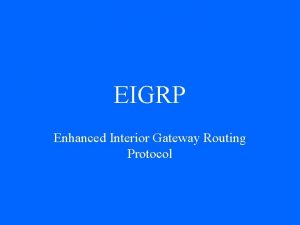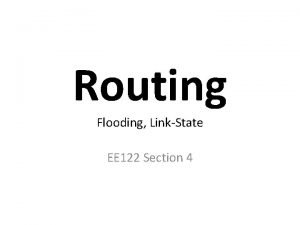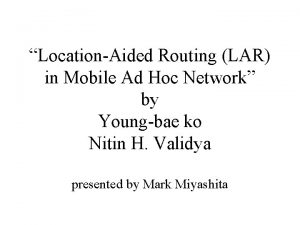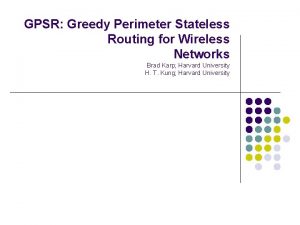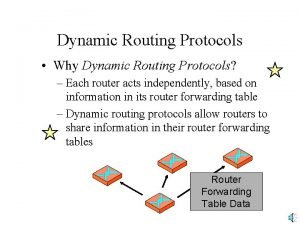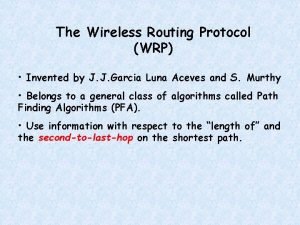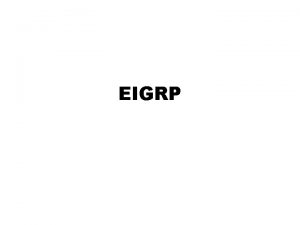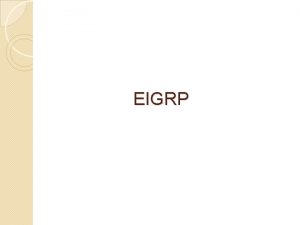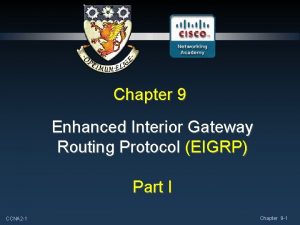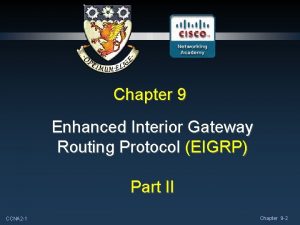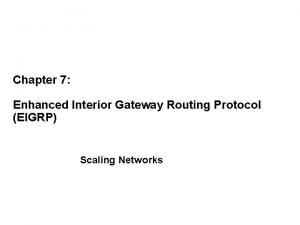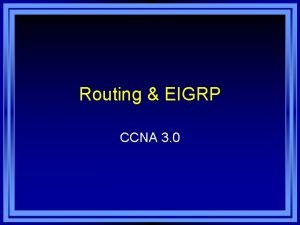EIGRP Enhanced Interior Gateway Routing Protocol WHAT IS













- Slides: 13

EIGRP (Enhanced Interior Gateway Routing Protocol)

WHAT IS EIGRP ? � � EIGRP (Enhanced Interior Gateway Routing Protocol) is a network protocol that lets routers exchange information more efficiently than with earlier network protocols. EIGRP evolved from IGRP (Interior Gateway Routing Protocol) and routers using either EIGRP and IGRP can interoperate because the metric (criteria used for selecting a route) used with one protocol can be translated into the metrics of the other protocol. EIGRP can be used not only for Internet Protocol (IP) networks but also for Apple. Talk and Novell Net. Ware networks.

EIGRP METRICS � EIGRP 256 scales IGRP’s metrics by a factor of � IGRP metric = 24 bits; EIGRP metric = 32 bits � Bandwidth and Delay are equally weighted � Reliability, Load, and MTU are off by default � Hop count limited to 224 (IGRP’s limit is 255) � To remember of metric EIGRP components: � Big = Bandwidth � Dogs = Delay � Really = Reliability � Like = Load � Me = MTU

EIGRP FOR IP � No updates. Route updates sent only when a change occurs � Hello messages sent to neighbors every 5 seconds (60 seconds in most WANs) Enhanced IGRP EIGRP

CONFIGURING EIGRP FOR IP AS=10 A 10. 1. 0 Enable EIGRP Assign networks B C 172. 16. 10. 0 192. 168. 0. 0 Router(config)#router eigrp 10 Router(config-router)#network 10. 0 Router(config-router)#network 172. 16. 0. 0 If you use the same AS number for EIGRP as IGRP, EIGRP will automatically redistribute IGRP into EIGRP

EIGRP METRICS (4) The table in the figure shows the default delay values for various interfaces. Notice that the default value is 20, 000 microseconds for Serial interfaces and 100 microseconds for Fast. Ethernet interfaces.

COMPARING BETWEEN EIGRP & IGRP EIGRP Classful Routing Protocol Classless Routing Protocol • VLSM, CIDR bandwidth = (10, 000/bandwidth kbps) delay = delay/10 24 bit metric for bandwidth and delay bandwidth = (10, 000/bandwidth kbps) * 256 delay = (delay/10) * 256 32 bit metric for bandwidth and delay Maximum Hop Count = 255 Maximum Hop Count = 224 No differentiation between internal and external routes. Outside routes (redistributed) are tagged as external routes. Automatic redistribution between IGRP and EIGRP as long as “AS” numbers are the same.

DISPLAYING INTERFACE VALUES R 1> show interface fa 0/0 Ethernet 0 is up, line protocol is up Hardware is Lance, address is 0010. 7 b 3 a. cf 84 (bia 0010. 7 b 3 a. cf 84) MTU 1500 bytes, BW 100000 Kbit, DLY 100 usec, rely 255/255, load 1/255 <output omitted> R 3> show interface s 0/0 Serial 0/0 is up, line protocol is up Hardware is QUICC Serial Description: Out to R 1 Internet address is 192. 168. 64. 5/30 MTU 1500 bytes, BW 1544 Kbit, DLY 20000 usec, rely 255/255, load 246/255 <output omitted>

Determining the Bandwidth between R 1 & R 2 Bandwidth = (10, 000/bandwidth kbps) * 256 Delay = 2, 560 Fast. Ethernet = (10, 000/100, 000) * 256 Fa 0/0 192. 168. 72. 1/24 = 25, 600 T 1 Bandwidth = 25, 600 R 1 = (10, 000/1544) * 256 S 0/0 192. 168. 64. 2/30 S 0/1 192. 168. 64. 6/30 = 1, 657, 856 Delay = 512, 000 S 0/0 192. 168. 64. 1/30 S 0/0 192. 168. 64. 5/30 Fa 0/0 192. 168. 1. 2/24 R 3 R 2 Fa 0/0 192. 168. 1. 1/24 EIGRP AS 100 Bandwidth = 1, 657, 856

Determining the Delay between R 1 & R 2 Delay = (delay/10) * 256 Delay = 2, 560 Fast. Ethernet = (100/10) * 256 Fa 0/0 192. 168. 72. 1/24 Bandwidth = 25, 600 = 2, 560 R 1 S 0/0 192. 168. 64. 2/30 T 1 S 0/1 192. 168. 64. 6/30 = (20, 000/10) * 256 Delay = 512, 000 S 0/0 192. 168. 64. 1/30 S 0/0 192. 168. 64. 5/30 Fa 0/0 192. 168. 1. 2/24 R 3 R 2 Fa 0/0 192. 168. 1. 1/24 EIGRP AS 100 Bandwidth = 1, 657, 856

Determining the cost between R 1 & R 2 What is the cost (metric) for 192. 168. 72. 0/24 from R 2? Delay = 2, 560 Cost: Slowest bandwidth + sum of delays 1, 657, 856 512, 000 2, 560 -------2, 172, 416 Fa 0/0 192. 168. 72. 1/24 Bandwidth = 25, 600 R 1 S 0/0 192. 168. 64. 2/30 S 0/1 192. 168. 64. 6/30 The cost! Delay = 512, 000 S 0/0 192. 168. 64. 1/30 S 0/0 192. 168. 64. 5/30 Fa 0/0 192. 168. 1. 2/24 R 3 R 2 Fa 0/0 192. 168. 1. 1/24 bandwidth = (10, 000/bandwidth kbps) * 256 delay = (delay/10) * 256 EIGRP AS 100 Bandwidth = 1, 657, 856 Slowest!

THE ROUTING TABLE Administrative Distance / Metric R 3#show ip route D 192. 168. 72. 0/24 [90/2172416] via 192. 168. 64. 6, 00: 28: 26, Serial 0

Thank you for listing
 Enhanced interior gateway routing protocol
Enhanced interior gateway routing protocol Mark tinka
Mark tinka Hydrologic routing and hydraulic routing
Hydrologic routing and hydraulic routing Clock and power routing in vlsi
Clock and power routing in vlsi Difference between channel routing and reservoir routing
Difference between channel routing and reservoir routing Link state routing protocol
Link state routing protocol Lar routing protocol
Lar routing protocol Ospfv
Ospfv Dhcp routing protocol
Dhcp routing protocol Distance vector count to infinity
Distance vector count to infinity What is gpsr
What is gpsr Ospf routing protocol
Ospf routing protocol Wrp protocol
Wrp protocol Eigrp otp
Eigrp otp
